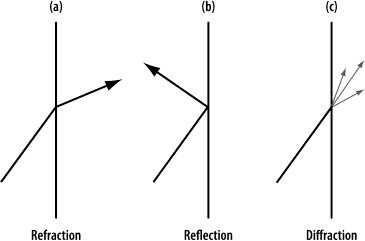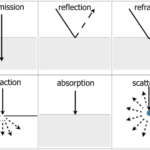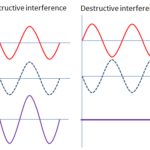Previously in Lesson 3, the behavior of waves traveling along a rope from a more dense medium to a less dense medium (and vice versa) was discussed. The wave doesn’t just stop when it reaches the end of the medium. Rather, a wave will undergo certain behaviors when it encounters the end of the medium. Specifically, there will be some reflection off the boundary and some transmission into the new medium. But what if the wave is traveling in a two-dimensional medium such as a water wave traveling through ocean water? Or what if the wave is traveling in a three-dimensional medium such as a sound wave or a light wave traveling through air? What types of behaviors can be expected of such two- and three-dimensional waves?
 The study of waves in two dimensions is often done using a ripple tank. A ripple tank is a large glass-bottomed tank of water that is used to study the behavior of water waves. A light typically shines upon the water from above and illuminates a white sheet of paper placed directly below the tank. A portion of light is absorbed by the water as it passes through the tank. A crest of water will absorb more light than a trough. So the bright spots represent wave troughs and the dark spots represent wave crests. As the water waves move through the ripple tank, the dark and bright spots move as well. As the waves encounter obstacles in their path, their behavior can be observed by watching the movement of the dark and bright spots on the sheet of paper. Ripple tank demonstrations are commonly done in a Physics class in order to discuss the principles underlying the reflection, refraction, and diffraction of waves.
The study of waves in two dimensions is often done using a ripple tank. A ripple tank is a large glass-bottomed tank of water that is used to study the behavior of water waves. A light typically shines upon the water from above and illuminates a white sheet of paper placed directly below the tank. A portion of light is absorbed by the water as it passes through the tank. A crest of water will absorb more light than a trough. So the bright spots represent wave troughs and the dark spots represent wave crests. As the water waves move through the ripple tank, the dark and bright spots move as well. As the waves encounter obstacles in their path, their behavior can be observed by watching the movement of the dark and bright spots on the sheet of paper. Ripple tank demonstrations are commonly done in a Physics class in order to discuss the principles underlying the reflection, refraction, and diffraction of waves.
Reflection of Waves
If a linear object attached to an oscillator bobs back and forth within the water, it becomes a source of straight waves. These straight waves have alternating crests and troughs. As viewed on the sheet of paper below the tank, the crests are the dark lines stretching across the paper and the troughs are the bright lines.  These waves will travel through the water until they encounter an obstacle – such as the wall of the tank or an object placed within the water. The diagram at the right depicts a series of straight waves approaching a long barrier extending at an angle across the tank of water. The direction that these wavefronts (straight-line crests) are traveling through the water is represented by the blue arrow. The blue arrow is called a ray and is drawn perpendicular to the wavefronts. Upon reaching the barrier placed within the water, these waves bounce off the water and head in a different direction. The diagram below shows the reflected wavefronts and the reflected ray. Regardless of the angle at which the wavefronts approach the barrier, one general law of reflection holds true: the waves will always reflect in such a way that the angle at which they approach the barrier equals the angle at which they reflect off the barrier. This is known as the law of reflection. This law will be discussed in more detail in Unit 13 of The Physics Classroom.
These waves will travel through the water until they encounter an obstacle – such as the wall of the tank or an object placed within the water. The diagram at the right depicts a series of straight waves approaching a long barrier extending at an angle across the tank of water. The direction that these wavefronts (straight-line crests) are traveling through the water is represented by the blue arrow. The blue arrow is called a ray and is drawn perpendicular to the wavefronts. Upon reaching the barrier placed within the water, these waves bounce off the water and head in a different direction. The diagram below shows the reflected wavefronts and the reflected ray. Regardless of the angle at which the wavefronts approach the barrier, one general law of reflection holds true: the waves will always reflect in such a way that the angle at which they approach the barrier equals the angle at which they reflect off the barrier. This is known as the law of reflection. This law will be discussed in more detail in Unit 13 of The Physics Classroom.

 The discussion above pertains to the reflection of waves off of straight surfaces. But what if the surface is curved, perhaps in the shape of a parabola? What generalizations can be made for the reflection of water waves off parabolic surfaces? Suppose that a rubber tube having the shape of a parabola is placed within the water. The diagram at the right depicts such a parabolic barrier in the ripple tank. Several wavefronts are approaching the barrier; the ray is drawn for these wavefronts. Upon reflection off the parabolic barrier, the water waves will change direction and head towards a point. This is depicted in the diagram below. It is as though all the energy being carried by the water waves is converged at a single point – the point is known as the focal point. After passing through the focal point, the waves spread out through the water. Reflection of waves off of curved surfaces will be discussed in more detail in Unit 13 of The Physics Classroom.
The discussion above pertains to the reflection of waves off of straight surfaces. But what if the surface is curved, perhaps in the shape of a parabola? What generalizations can be made for the reflection of water waves off parabolic surfaces? Suppose that a rubber tube having the shape of a parabola is placed within the water. The diagram at the right depicts such a parabolic barrier in the ripple tank. Several wavefronts are approaching the barrier; the ray is drawn for these wavefronts. Upon reflection off the parabolic barrier, the water waves will change direction and head towards a point. This is depicted in the diagram below. It is as though all the energy being carried by the water waves is converged at a single point – the point is known as the focal point. After passing through the focal point, the waves spread out through the water. Reflection of waves off of curved surfaces will be discussed in more detail in Unit 13 of The Physics Classroom.

Refraction of Waves
Reflection involves a change in direction of waves when they bounce off a barrier. Refraction of waves involves a change in the direction of waves as they pass from one medium to another. Refraction, or the bending of the path of the waves, is accompanied by a change in speed and wavelength of the waves. In Lesson 2, it was mentioned that the speed of a wave is dependent upon the properties of the medium through which the waves travel. So if the medium (and its properties) is changed, the speed of the waves is changed. The most significant property of water that would affect the speed of waves traveling on its surface is the depth of the water. Water waves travel fastest when the medium is the deepest. Thus, if water waves are passing from deep water into shallow water, they will slow down. And as mentioned in the previous section of Lesson 3, this decrease in speed will also be accompanied by a decrease in wavelength. So as water waves are transmitted from deep water into shallow water, the speed decreases,  the wavelength decreases, and the direction changes.
the wavelength decreases, and the direction changes.
This boundary behavior of water waves can be observed in a ripple tank if the tank is partitioned into a deep and a shallow section. If a pane of glass is placed in the bottom of the tank, one part of the tank will be deep and the other part of the tank will be shallow. Waves traveling from the deep end to the shallow end can be seen to refract (i.e., bend), decrease wavelength (the wavefronts get closer together), and slow down (they take a longer time to travel the same distance). When traveling from deep water to shallow water, the waves are seen to bend in such a manner that they seem to be traveling more perpendicular to the surface. If traveling from shallow water to deep water, the waves bend in the opposite direction. The refraction of light waves will be discussed in more detail in a later unit of The Physics Classroom.
Diffraction of Waves
Reflection involves a change in direction of waves when they bounce off a barrier; refraction of waves involves a change in the direction of waves as they pass from one medium to another; and diffraction involves a change in direction of waves as they pass through an opening or around a barrier in their path. Water waves have the ability to travel around corners, around obstacles and through openings. This ability is most obvious for water waves with longer wavelengths. Diffraction can be demonstrated by placing small barriers and obstacles in a ripple tank and observing the path of the water waves as they encounter the obstacles. The waves are seen to pass around the barrier into the regions behind it; subsequently the water behind the barrier is disturbed. The amount of diffraction (the sharpness of the bending) increases with increasing wavelength and decreases with decreasing wavelength. In fact, when the wavelength of the waves is smaller than the obstacle, no noticeable diffraction occurs.
involves a change in the direction of waves as they pass from one medium to another; and diffraction involves a change in direction of waves as they pass through an opening or around a barrier in their path. Water waves have the ability to travel around corners, around obstacles and through openings. This ability is most obvious for water waves with longer wavelengths. Diffraction can be demonstrated by placing small barriers and obstacles in a ripple tank and observing the path of the water waves as they encounter the obstacles. The waves are seen to pass around the barrier into the regions behind it; subsequently the water behind the barrier is disturbed. The amount of diffraction (the sharpness of the bending) increases with increasing wavelength and decreases with decreasing wavelength. In fact, when the wavelength of the waves is smaller than the obstacle, no noticeable diffraction occurs.
Diffraction of water waves is observed in a harbor as waves bend around small boats and are found to disturb the water behind them. The same waves however are unable to diffract around larger boats since their wavelength is smaller than the boat. Diffraction of sound waves is commonly observed; we notice sound diffracting around corners, allowing us to hear others who are speaking to us from adjacent rooms. Many forest-dwelling birds take advantage of the diffractive ability of long-wavelength sound waves. Owls for instance are able to communicate across long distances due to the fact that their long-wavelength hoots are able to diffract around forest trees and carry farther than the short-wavelength tweets of songbirds. Diffraction is observed of light waves but only when the waves encounter obstacles with extremely small wavelengths (such as particles suspended in our atmosphere). Diffraction of sound wavesand of light waves will be discussed in a later unit of The Physics Classroom Tutorial.
Reflection, refraction and diffraction are all boundary behaviors of waves associated with the bending of the path of a wave. The bending of the path is an observable behavior when the medium is a two- or three-dimensional medium. Reflection occurs when there is a bouncing off of a barrier. Reflection of waves off straight barriers follows the law of reflection. Reflection of waves off parabolic barriers results in the convergence of the waves at a focal point. Refraction is the change in direction of waves that occurs when waves travel from one medium to another. Refraction is always accompanied by a wavelength and speed change. Diffraction is the bending of waves around obstacles and openings. The amount of diffraction increases with increasing wavelength.


